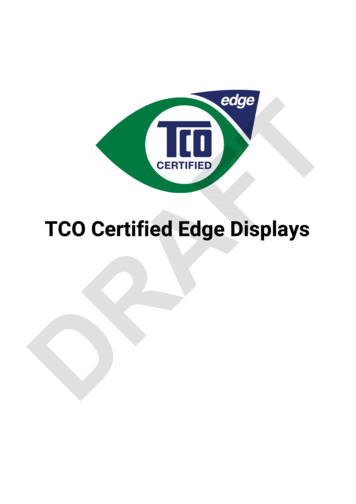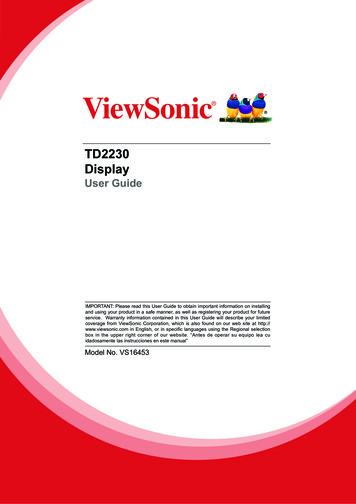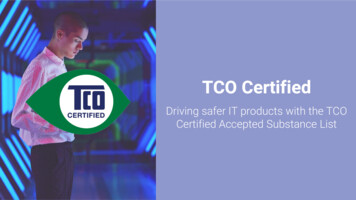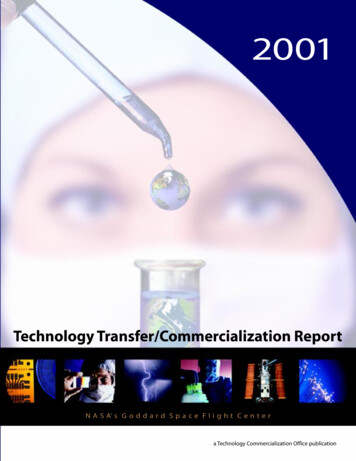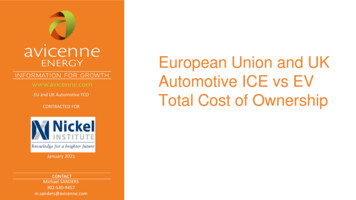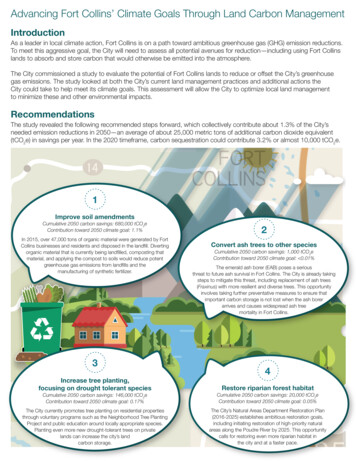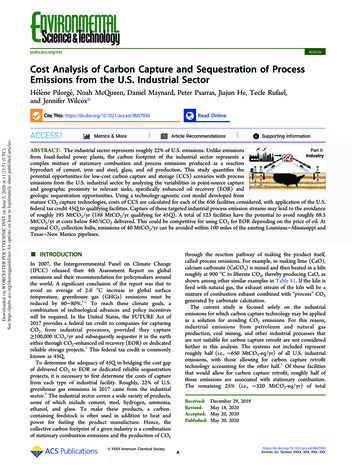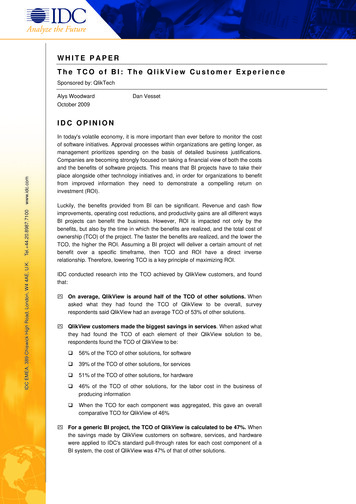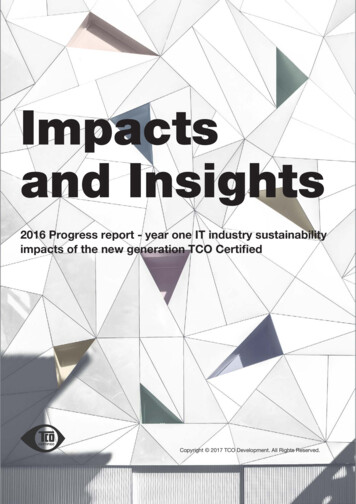
Transcription
Impactsand Insights2016 Progress report - year one IT industry sustainabilityimpacts of the new generation TCO CertifiedCopyright 2017 TCO Development. All Rights Reserved.
ContentsAbout this report. . . . . . . . . . . . . . . . . . . . . . . . . . . . . . . . . . . . . . . . . . . . . . . 3Driving progresstoward a sustainableIT product life cycleA word from our CEO. . . . . . . . . . . . . . . . . . . . . . . . . . . . . . . . . . . . . . . . . . . 4Improvements and remaining challenges . . . . . . . . . . . . . . . . . . . . . . . . . . . 5ABOUT TCO CERTIFIED. . . . . . . . . . . . . . . . . . . . . 6Sustainability throughout the product life cycle. . . . . . . . . . . . . . . . . . . . . . . 7Independent verification in TCO Certified. . . . . . . . . . . . . . . . . . . . . . . . . . . . 8Verification rounds, 2016. . . . . . . . . . . . . . . . . . . . . . . . . . . . . . . . . . . . . . . . .9A new generation TCO Certified. . . . . . . . . . . . . . . . . . . . . . . . . . . . . . . . . . . 10COMMUNITY. . . . . . . . . . . . . . . . . . . . . . . . . . . . . 11TCO Certified is the world’s most comprehensivesustainability certification for IT products, helpingorganizations make responsible product choices.Building a community of best practice. . . . . . . . . . . . . . . . . . . . . . . . . . . . . . 12Stakeholders have direct impact. . . . . . . . . . . . . . . . . . . . . . . . . . . . . . . . . . . 13For 25 years we have provided solutions for reducingrisk and meeting sustainability challenges connected toelectronics.IMPACTS. . . . . . . . . . . . . . . . . . . . . . . . . . . . . . . 14Socially Responsible Manufacturing. . . . . . . . . . . 15Brand owner improvements in factory working conditions. . . . . . . . . . . . . . . 16TCO Certified includes life cycle criteria for environmentaland social responsibility and is a Type 1 Ecolabel inaccordance with ISO 14024.Case study; tracking brand owner factory progress, 2013-2016. . . . . . . . . . 17Brand owner collaboration drives faster factory improvements. . . . . . . . . . . 19Greater commitment to conflict minerals initiatives . . . . . . . . . . . . . . . . . . . . 21Independent verification of product, factory and brandowner compliance, both pre and post certification, isincluded in TCO Certified.Hazardous Chemicals. . . . . . . . . . . . . . . . . . . . . . 22A paradigm shift in identifying safer chemicals. . . . . . . . . . . . . . . . . . . . . . . . 23IT Industry’s Proactive Work. . . . . . . . . . . . . . . . . 24Proactive work in socially responsible manufacturing . . . . . . . . . . . . . . . . . . 25CONCLUSIONS AND MOVING FORWARD. . . . . . . . 26Progress made and areas for further action. . . . . . . . . . . . . . . . . . . . . . . . . . 27Join us as the work continues. . . . . . . . . . . . . . . . . . . . . . . . . . . . . . . . . . . . . 282
About thisreportThrough independent certification, communityengagement and industry insight, TCO Certified hascontinued to drive sustainability improvements in theIT industry in 2016. As part of our regular three yearcriteria development cycle, measuring the impact ofTCO Certified is an important step in this process.This progress report outlines some key findingsfrom year one of the new generation TCO Certified,launched at the end of 2015. Findings are basedon post certification verification rounds carried outduring 2016, to assess IT product, factory and brandcompliance with criteria for environmental and socialresponsibility.A case study compares 2013-2016 outcomes insocially responsible manufacturing practices in tier onefactories making certified product models for 16 brandowners; Acer, AOC, ASUS, BenQ, Dell, EIZO, Fujitsu,Hanns.G, HP, iiyama, Lenovo, LG, NEC, Philips,TERRA and ViewSonic. Conclusions show measurablebrand owner improvement in code of conductcompliance and corrective actions, while excessiveworking hours is a continuing problem.Other impacts include greater brand ownerengagement in initiatives in conflict minerals and aparadigm shift in identifying safer flame retardantchemicals for use in certified products.Through our annual brand owner reviews, we havealso seen growth in industry’s commitment tosustainability initiatives, even beyond the scope ofTCO Certified.For the purposes of this report, the term “brandowner” refers to the companies owning the brandnames under which TCO Certified products are sold.TCO Certified is a product certification. Complianceapplies to specific product models and themanufacturing facilities where they are made. Whileresponsibility for compliance is placed on the brandowner, TCO Certified does not indicate certification orcompliance of the brand as a whole.3
A word from our CEO»Collaboratingfor next levelimpacts«As engagement in sustainability issues grows, TCOCertified continues the drive toward IT products thatare more environmentally and socially sustainable.Through independent certification, communityengagement and insight, TCO Certified provides purchasersand industry worldwide with a verified way to make moreresponsible choices.This progress report highlights some important findingsfrom our most recent product and factory post certificationverification rounds and annual reviews with brand owners.Through this process we’ve observed measurable progressin supply chain responsibility and improvements in code ofconduct compliance, while challenges persist in working hours,something that will demand our continued attention.In 2016 we marked a number of firsts. A new generation TCOCertified was in place, introducing criteria for conflict mineralsand safer flame retardant chemicals, while increasing brandowner responsibility for socially responsible manufacturing.Through our verification rounds, we also developed a newmodel for more effective corrective actions in workingconditions in manufacturing. We also continued our regularreviews of brand owner proactive work and engaged withstakeholders in sharing best practices and strategic approachesto solving sustainability challenges.A world where IT products have a sustainable life cycle is anambitious vision and there are a lot of issues that need to beaddressed. Together, we will need to re-dedicate ourselves tocontinued improvement in reducing social and environmentalproblems.Join us in this important mission. As a purchaser, your use ofTCO Certified when choosing computers, displays and other ITproducts has a direct effect on industry’s progress. For brandowners, certifying your products is independent proof of yourcommitment to a more sustainable, responsible product lifecycle.Some highlights from 2016:Our next generation TCO Certified is targeted for release in2018 and will lead worldwide progress toward this goal. Wewelcome our continued work together to make IT productsmore sustainable for everyone. A new generation TCO Certified in place 27 brand owners offering certified products Improvements in working conditions where certified productsare made A public list of accepted chemical substances, representinga paradigm shift in the reduction and substitution of hazardouschemicals Greater sustainability commitments from purchasers Inaugural Sustainable IT Summit and webinar seriesSören EnholmCEO, TCO Development4
SummaryImprovements andremaining challenges2016 was year one of the new generation TCO Certified, resulting in greater ITbrand owner action to improve socially responsible manufacturing, commitment toconflict minerals initiatives and a new approach to choosing safer chemicals.Through working with our stakeholders in purchasing, industry and sustainability, we have alsocontinued to build a community focused on the common goal of driving a more sustainableproduct life cycle for IT products.Some key impacts included in this report- based on our 2016 post certification verification rounds:A. Socially responsiblemanufacturingB. HazardouschemicalsC. IT industry’sproactive workGreater brand ownerresponsibility, resulting inimproved code of conductcomplianceA paradigm shift in hazardouschemicalsInsights into broader proactiveengagement in socialresponsibility initiativesCase study of 16 brand ownerscompares 2013-2016 data oncompliance with code of conduct.Brand owners included in the case study:Acer, AOC, ASUS, BenQ, Dell, EIZO,Fujitsu, Hanns.G. HP, iiyama, Lenovo,LG, NEC, Philips, TERRA and ViewSonic.Major findings include:Moving from chemicals with unknownhuman health and environmental effects,to safer chemicals where these effectsare known. Only flame retardant chemicals thathave been independently assessed andbenchmarked as safer alternatives areused in certified products Increased transparency througha public list of safer, accepted flameretardant chemicals Measurable improvements in sociallyresponsible manufacturing where TCOCertified products are made Reduction from 16 brand ownersin 2013 to 2 in 2016 showing code ofconduct violations. Remaining twobrand owners showed health and safetynonconformities, which have since beenremediated Compliance with labor law provisions,particularly working hours, is still apersistent problem industry-wide, despitesome measurable improvement amongcertifying brand owners Improved engagement in conflictminerals initiatives5We have observed: Improved engagement in systemsfor handling corruption and workergrievances, along with greater supplychain sustainability Further investigation needed inpreventing nonconformities in workingconditions and better knowledge ofsupply chain
ABOUTTCO CERTIFIED.6
About TCO CertifiedSustainability throughout theproduct life cycleTCO Certified is the world’s most comprehensive sustainability certification for ITproducts, helping organizations make responsible product choices.For 25 years we have provided solutions for reducing risk and meeting sustainabilitychallenges connected to electronics.TCO Certified includes life cyclecriteria for environmental andsocial responsibility and is a Type1 Ecolabel in accordance with ISO14024. Independent verification ofproduct, factory and brand ownercompliance, both pre and postcertification, is included in TCOCertified.Available for displays, notebooks,smartphones, tablets, all-in-onePCs, desktops, projectors andheadsets.Criteria summaryElectronics are associated with many sustainability risks throughout the lifecycle, such as working conditions in manufacturing, negative environmentaleffects, energy consumption, hazardous substances, usability and e-waste.TCO Certified contains criteria aimed at addressing many of these challenges.Socially responsible manufacturingCode of Conduct, independent factory audits, brand ownerinitiatives, conflict mineralsEnvironmental Management SystemISO 14001 or EMAS registered. Independent measure ofenvironmental improvementsClimate / energy efficiencyEnergy Star (where applicable). Energy efficiency of productand power supplyErgonomic designVisual quality (for display products) ergonomic design, usabilityHealth, safety, emissionsAcoustic noise protection, low emissions, electrical safetyExtended product lifeProduct warranties, availability of replacement partsHazardous substances in product and packagingLimits on phthalates, halogens, assessment of non-halogenatedflame retardantsProduct and packaging designed for recyclingCoding of plastics, limits on number of different plastics, allpackaging recyclableProduct take backBrand owner offers product take back at end of life7
Independent verificationin TCO CertifiedIndependent verification is a cornerstone of TCO Certified. Assessment of product,factory, and brand owner compliance takes place both pre and post certification.Confirming compliance with TCO Certified is vital for ensuring trust among the purchasers andbrand owners that use it. The process also provides direct access to industry conditions andinsights, allowing us to measure progress and identify hot spots that demand our continuedattention.All testing and verification in TCO Certified is carried out by independent test and verificationpartner organizations, typically world-renown test houses that specialize in electronics, socialresponsibility or sustainability issues.1. PrecertificationFACTORY / BRANDCOMPLIANCEVerification of compliance withcriteria before we certify a licationBrand owner applies for TCO CertifiedFOLLOW UPFACTORY AUDITBRAND SOCIALENGAGEMENTFOLLOW UPPRODUCT TESTING2. PostcertificationAnnual follow up verificationafter certification of productINDEPENDENTVERIFICATIONCopyright 2017 TCO Development. All Rights Reserved8Accuracy andreassurancethroughindependentverificationAll organizations verifying for TCOCertified are independently accredited inaccordance with ISO/IEC 17025.All detected nonconformities in TCOCertified products must be correctedthough a corrective action plan withina reasonable time frame, which isdetermined based on severity andcomplexity of the problem. This is onethe most important aspects when drivingimprovements in the IT industry.
Verification rounds, 2016In 2016 we carried out a number of follow up verification and quality assuranceactivities, including:1. Post certification verification- products, factories and brandowner responsibility3. Review of brand ownerproactive workA detailed review with a brand owner representative,who is designated as responsible for socially responsiblemanufacturing. The review focuses on the company’s proactivework in socially responsible manufacturing and actions takento prevent future nonconformities. The review is designed toshow where strengths and weaknesses exist and is aimed atcontinuous improvement at each review. In 2016 we carried outthe review with 19 brand owners.As part of our annual product follow up program, we haveretested a selection of certified product models. Testingincludes analysis of chemical content and ergonomic aspectssuch as display luminance and color performance, along withother factors. Products are typically selected based on variousrisk factors, for example products with an extended certificatelife or where several variations of a display panel have beenused. Products are also selected to represent a wide range ofbrands.4. Review of verification partnersWith multiple accredited test and verification partners, each sitemust deliver accurate, repeatable results, regardless of location.During 2016 we carried out our regular ‘round robin’ producttesting, where a single product sample is tested at all testsites. The purpose is to ensure consistency of test methods,equipment calibration and criteria interpretation.As the number of manufacturing sites entering the TCOCertified program grows, so does our compliance monitoringof factories manufacturing certified products. During 2016 wecarried out a number of follow up factory audits.2. Review of TCO Certified systemEvery test and verification site is also subject to annualaccreditation in accordance with the International LaboratoryAccreditation Cooperation (ILAC), the international organizationfor accreditation of conformity assessment bodies includingcalibration laboratories (using ISO/IEC 17025)We have conducted an internal review of all processes androutines in TCO Certified, to ensure consistency and accuracyin accordance with the requirements for ISO 14024 Type 1Ecolabels. TCO Certified has also met the requirements forthe Global Ecolabelling Network’s GENICES peer reviewaccreditation, in accordance with ISO 14024.5. Brand claims monitoringMore information We have continued our ongoing efforts to ensure continuedaccuracy in any product claims related to TCO Certified.Brand owner websites and promotional materials are regularlyreviewed and corrected for this purpose.9
A new generation TCO CertifiedA new generation TCO Certified is launched every three years, with the latestgeneration in November 2015. This rapid development cycle allows us to designprogressive criteria that are in line with current technologies and that can drivefaster progress in targeted areas.Throughout the process, we invite input from an international group of stakeholders andinterested parties, representing brand owners, manufacturers, purchasers, technical andscientific experts, NGOs and interest groups.TCO Certified criteria development cycleStakeholder DialogContinuous throughout the three year cycleYear threeYear oneDraft and launchof new versionAnalysis anddirectionYear twoResearch andcriteria developmentCopyright 2017 TCO Development. All Rights ReservedFocus criteria in the new generationSocially responsible manufacturing Reduction of hazardous chemicalsExpanded brand owner responsibility for supply chainworking conditions and implementation of correctiveactions.Brand owners bear the ultimate responsibility for socialresponsibility in the supply chain and new criteria expand thisresponsibility to focus on improved closure of corrective actionsand further implementation of the code of conduct in the supplychain. The goal is to drive improvements in the brand owner’sstructured work, close nonconformities and minimize the risk offuture violations.Brand owner commitment to conflict mineralsinitiativesA new paradigm for identifying safer flame retardantsWhile toxic halogens are largely phased out of certifiedproducts, too little is known about the non-halogenatedchemical flame retardants used to replace them. TCO Certifiedhas added criteria aimed at increasing transparency aroundthese chemicals; eliminating the most hazardous, identifyingsafer alternatives and making this information public. Thisassessment is carried out using the GreenScreen for SaferChemicals hazard assessment tool. The chemicals approvedfor use in TCO Certified products are published in theTCO Certified Accepted Substance List, available at www.tcodevelopment.com. The list represents a shift from thetraditional approach of listing banned substances only.Brand owners must prove their involvement in programs aimedat establishing a conflict-free supply chain of Tantalum, Tin,Tungsten and Gold (3T G). This includes supporting in-regionresponsible sourcing programs or implementing an OECD duediligence process. This helps suppliers meet due diligencerequirements, and develop a legitimate mining industry thatdirectly benefits the people whose livelihoods depend on it.10
COMMUNITY.11
Building a communityof best practiceProgress is best made when there’s open and constructive stakeholder dialog,aimed at more transparency and achieving common objectives. IT purchasersare increasingly aware of the social and environmental risks associated withelectronics. Using TCO Certified helps support responsible purchasing decisionsand verification of product compliance.Brand owners turn to TCO Certified for independent validation of their product attributesand sustainability progress, making it easier to secure buyer trust. As an independentorganization, we are uniquely positioned to offer buyers, brand owners and experts a platformfor exchanging knowledge and best practice. This progressive dialog is vital for developingmutually beneficial solutions.Communityengagementhighlights, 2016Sustainable IT SummitInaugural TCO Development Sustainable ITSummit. Held to mark the launch of the latestgeneration TCO Certified, the Summit broughttogether leading voices from industry andpurchasing communities to share best practicesand discuss strategic approaches for higherimpact.Webinar series2016 Sustainable IT Webinar Series – a learningplatform for sharing the latest research andinitiatives from brand owners, research expertsand purchasing leaders. Continuing in 2017.Dialog with brand ownersAnnual review with brand owners. As anextension of the certification process, wecarry out an annual dialog with each brandowner about their proactive work to furthertheir commitment to environmental and socialresponsibility.
Stakeholders have direct impactPurchasersBrand ownersReducing risk, impacting industryCertified product models from 27brand ownersPurchaser use of TCO Certified is critical to driving positivechange, including at the factory level. Through their continueduse of TCO Certified as part of a sustainable purchasingprogram, organizations around the world have been able toreduce their environmental and social risks when buying ITproducts and send a clear message to industry. Easier to make more responsible IT product choicesCertifying product models makes it easier for brand ownersto meet buyer demand, gain access to volume contractsand show compliance with current, relevant sustainabilitycriteria. They also benefit from from the structured platform forcontinuous improvement that TCO Certified offers. Progressivecriteria and independent verification help brand owners reducesustainability risk and provide validation of progress andproduct claims. Independent verification is included - no need to do ityourselfBrand owners offering TCO Certifiedproducts, 2016 Easier to reduce the social and environmental risks of ITproductsAcer, AOC, ASUS, BenQ, Casio, Casper, Dell, EIZO, Founder,Fujicom, Fujitsu, Genuine, Hanns.G, HP, iiyama, Jabra, Lenovo,LG, MEDION, MSI, NEC, Philips, Plantronics, Samsung, TERRA,VERSUS, ViewSonicBenefits to IT buyers include:Your purchasing choices drive change - by using TCO Certifiedyou have a direct impact on sustainability in the IT industry,including socially responsible manufacturing.Using TCOCertified is part ofa comprehensivesustainable IT strategyStrategic partnersCollaborating for greater impactContinual progress demands constant innovation. Working withour network of strategic partners is key to our ability to drivemeaningful change and provide decision support for purchasersand industry alike. This means being at the forefront of technicalinnovation and setting relevant criteria aimed at solving themost pressing social and environmental challenges.Among our collaborations in 2016: Continued partnership with accredited test and verificationorganizations TUV Rheinland, Nemko, Intertek, Goodpoint andSwerea IVF Integration of the Clean Production Action’s GreenScreen for Safer Chemicals hazard assessment tool in TCO Certified Sustainable Purchasing Leadership Council - IT HardwareTechnical Advisory Group ModUpp2020 - Sweden-based sustainable purchasingeducation initaitive Multi-stakeholder collaboration in sustainability, purchasing,legislative and voluntary initiatives, NGOs and interestorganizations13
IMPACTS.14
IMPACTS, ASociallyResponsibleManufacturingImpacts, 2016 Improved code of conductcompliance and implementation ofcorrective actions, especially whenbrand owners present collectivedemands to shared manufacturingsites Persistent challenges inadherence to labor laws, despitesome progress Greater brand owner engagementin conflict-minerals initiatives15
IMPACTS, A - Socially Responsible ManufacturingImpacts, A.1Brand owner improvements infactory working conditionsIn the new generation TCO Certified we have increased brand owner responsibilityfor code of conduct compliance and implementation, as well as follow up ofcorrective actions in factories where certified products are made.As shown in our 2016 case study of 16 brand owners, code of conduct compliance hasimproved, along with closure of corrective actions, despite some persistent challenges.A shift to greater brand ownerresponsibility for the supply chainBeginning in 2009, TCO Certified has included criteria forsocially responsible manufacturing. What started with branddeclarations of social responsibility initiatives, the criteriahas evolved into a structure for greater transparency andcontinuous improvement in supply chain working conditions.Prior to the 2012 generation, brand owners typically placedresponsibility for working conditions and corrective actionsonto manufacturing partners. The new generation shifts thisresponsibility to the brand owners. There are several reasonsfor this change: Manufacturer improvements are most often at the demand ofthe customer, in this case the brand owner. For a manufacturingsupplier, social responsibility is not always a priority and maybe outweighed by lead time, cost and other factors Brand owners have the most influence and opportunity toaffect working conditions in the supply chain Purchasing organizations generally consider brand ownersas having ultimate responsibility for supply chain workingconditionsTCO Certified criteria summary- socially responsiblemanufacturingBrand owner must implement a code of conduct,complying with: Eight ILO Core conventions UN Convention on the Rights of the Child, article 32 Health & Safety and labor laws in the country ofmanufactureTo prove compliance, brand owners must: While brand owner responsibility has been a key aspectin TCO Certified since 2012, we have observed that a singlebrand acting alone may not have enough leverage to driveeffective change at the factory level. in 2016 we have testeda new approach, based on collective demand-setting fromseveral brand owners at shared manufacturing sites. This newmethod has resulted in faster, more effective implementation ofcorrective actions Sign a legally binding license agreement with TCODevelopment Have a serious code of conduct and ensure it iscommunicated and implemented in the supply chain Regularly conduct audits of all factories manufacturingcertified products and send samples of these reports toTCO Development for reviewThere are however remaining challenges where nonconformitiesare still common, particularly in adherence to local labor laws.While there has been some measurable improvement, theseissues are continuing hot spots moving forward.An observation is that brand owners and their manufacturingpartners have a greater awareness of their social responsibilitycompared with our 2013 analysis, and while there are persistenthot spots, the level of overall engagement and preparednesshas improved.16 Handle nonconformities in the whole supply chain ina responsible way, in accordance with corrective actionplans Appoint a person responsible for implementation of thecode of conduct and for reporting to TCO Developmentannually Report proactive work annually, aimed at minimizingrisk of nonconformities against the code of conductCriteria in TCO Certified for conflict minerals; Brandowners shall: Publish a conflict minerals policy Commit to in-region initiatives or establish a duediligence process for conflict minerals
IMPACTS, A - Socially Responsible ManufacturingCase study; tracking brand ownerfactory progress, 2013-2016Improved working conditions, but challenges with labor lawsIn 2016 we studied progress in socially responsiblemanufacturing at tier one sites manufacturing TCO Certifiedproducts for 16 brand owners. This case study is based onfollow up verification with the same facilities assessed in 2013and included in our report “The State of Socially ResponsibleManufacturing in the IT Industry “(2014).The comparison is based on collected data from both 2013and 2016, tracking progress of the same brand owners andfactories, including results from third party audits. Verifiedaudit reports show major improvement in code of conductcompliance and closure in all but two areas of corrective actionby the end of 2016.One brand owner could not be included in this study as theyare no longer using the same manufacturing facility as in 2013,and therefore could not provide comparative data. That brandowner’s new facility is however subject to the same complianceand follow up requirements.Of note is that factory audits do also show some challenges ineffective assessment of freedom of association.However, adherence to labor laws is a continuing challenge, asviolations continue, despite some measurable improvement.Number of brands with nonconformities in factoriesmanufacturing TCO Certified products, 2013-2016.2013Number of brands11Forced laborDiscriminationFreedom of associationNonconformities - all levels32Rigths of the child11Health & safety16Labor laws162016Number of brandsForced labor 0Discrimination 0Freedom of association 0Levels of labor law violationsRigths of the child 0Health & safetyPriority nonconformities2Labor laws14Copyright 2017 TCO Development. All Rights Reserved17Major nonconformitiesMinor nonconformities
IMPACTS, A - Socially Responsible ManufacturingLabor laws - a measurable shift, but challenges persistDespite some progress, labor law nonconformitiespersist. These violations are most commonlyconnected with payment of wages as well asexcessive factory working hours.In our 2016 study, 14 of 16 brand owners showed somelevel of nonconformity with labor law provisions, in factoriesmanufacturing certified products.However, our observations reveal some improvement. Where11 brand owners in our 2013 analysis showed labor lawviolations at the highest “priority” level. The number of priorityviolations was reduced to zero in 2016.While the majority of brand owners still show some kind oflabor law nonconformity in the factories, the severity of thoseviolations has been reduced to either the “major” or “minor”levels.Important to note are the different characteristics of laborlaw compliance when compared with other code of conductaspects such as compliance with ILO and UN conventions. It isclear that progress in this area is more difficult and longer termas it involves legislative and public policy issues at the locallevel.Labor law is a complex issue, involving challenges not only withworking hours, but also with migrant workers, the employmentof students and temporary workers, among other issues.Labor law and non conformities16The most commonly observed labor lawconformities in our follow up verification are:Working hours-Excessive overtime-Child labor - juvenile workers doing night shifts-High percentage of tempworkers1 brand with minornonconformity143 brands with majornonconf
TCO Certified. For the purposes of this report, the term "brand owner" refers to the companies owning the brand names under which TCO Certified products are sold. TCO Certified is a product certification. Compliance applies to specific product models and the manufacturing facilities where they are made. While
